Overview
Spiders are arachnids, a class of arthropods that also includes scorpions, mites, and ticks. There are more than 45,000 known species of spiders, found in habitats all over the world. Spiders range in size from the tiny Samoan moss spider, which is .011 inch long, to the massive Goliath birdeater, a tarantula with a leg span of almost a foot.
Spiders construct loose, irregular webs in areas with higher relative humidity and moisture, such as homes, sheds, barns and warehouses. Within these structures, spider webs are usually found in dark and damp places, including but not limited to the corners of eaves, windows and ceilings in cellars, basements, crawlspaces and garages. In commercial buildings, spiders tend to spin webs in corners near doors that are left open.
Classification
- Phylum – Arthropoda
- Class – Arachnida
- Order – Araenae
- Suborder Mesothelae – segmented spiders
- Suborder Opisthothelae – includes all other spiders
Types of Spiders
American House Spiders
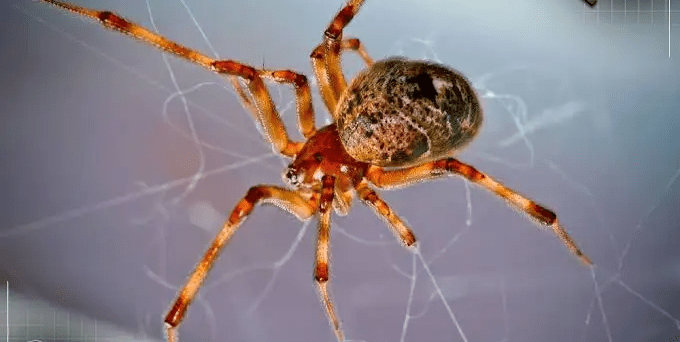
The common house spider or American house spider is a comb-footed spider that gets its name from the fact that it is usually the spider most often encountered indoors. The female common house spider is between 5 – 8 mm in length. Males are, like most species of spider, smaller. Their coloring is usually dark gray or brown with stripes or markings along their legs. They have thin legs and thicker, round, bodies. Although common house spiders will set up their webs in the wild, they have adapted well to urban sprawl and are often found in webs inside homes.
Brown Recluse spider
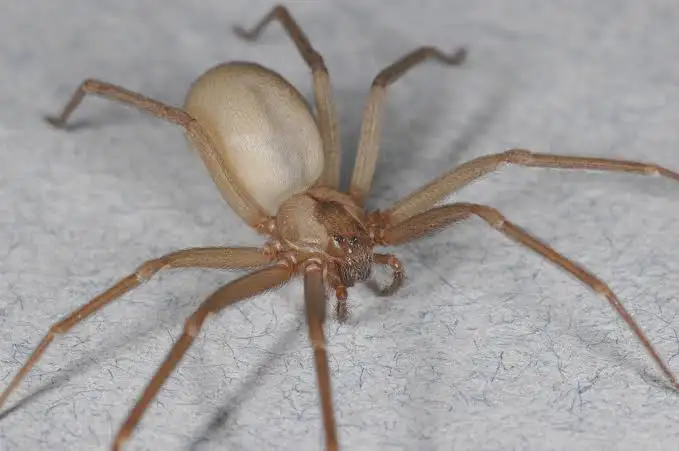
Brown recluse spiders are usually between 5.5 and 22 millimeters, but may grow larger. While typically light to medium brown, they range in color from whitish to dark brown or blackish gray. The cephalothorax and abdomen are not necessarily the same color.
These spiders usually have markings on the dorsal side of their cephalothorax, with a black line coming from it that looks like a violin with the neck of the violin pointing to the rear of the spider, resulting in the nicknames fiddleback spider, brown fiddler, or violin spider. Females are larger then males. The webs are small, irregular, and untidy. These spiders are usually seen walking or running around, not in a web. Most active at night, these spiders are nocturnal hunters and can survive for months without a food source.
Tarantula
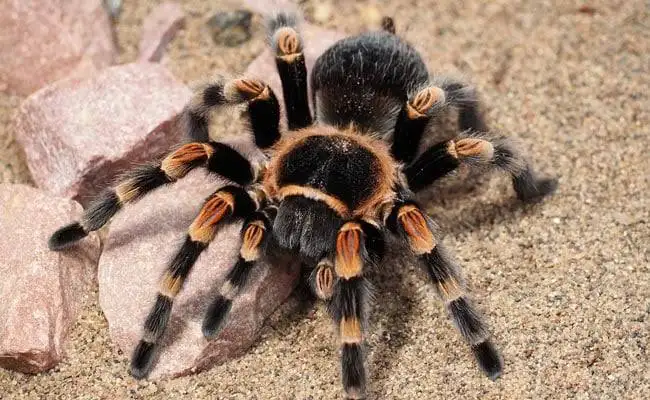
Like all spiders, tarantulas have eight legs and a very strong exoskeleton that, due to their size, is probably easier to see than on smaller spiders. Their body parts are separated into two segments: the prosoma (cephalothorax) and the abdomen, which is also known as the opisthosoma. The two segments are joined by a portion of the body known as the pedicle, but often just referred to as the “waist.”
A female tarantula has a more stocky body than a male and is covered in a light brown or tan hair (thus it is sometimes called the Arizona Blond Tarantula). The male is thinner and “lankier”, with black hair covering most of the body and reddish hairs on its abdomen. Tarantulas also have fangs (pedipalps). This is where they release venom when hunting and finding food. Since tarantulas are large, their fangs are often more prominent and easy to see than other species of spider.
Goliath Spider

Birdeaters are an incredibly large species of tarantula, and their leg-span can be up to 11 in. across. Like all tarantulas, they have a large abdomen and a smaller cephalothorax. This spider’s spinnerets are at the end of its abdomen, and its fangs are at the front of its cephalothorax.
They have very large fangs, which can be up to 1.5 in. long. Each fang is equipped with venom, but it is mild and not dangerous to humans unless you are allergic. Goliath Birdeater spiders are the largest spiders in the world, both in weight and size, but the giant huntsman spider does have a larger leg-span.
Unlike some tarantula species, these creatures live mainly in humid rainforests of South America. More specifically, they live in upland rainforests. Some of their favorite habitats are marshes and swamps located in the dense forest. They dig burrows in the soft, moist soil and hide within them.
Camel Spider

Camel spiders, also called wind scorpions and Egyptian giant solpugids. Despite the common names, they are neither true scorpions (order Scorpiones) nor true spiders (order aranaea). Most species of Solifugae live in dry climates and feed opportunistically on ground-dwelling arthropods and other small animals.
Wolf Spiders
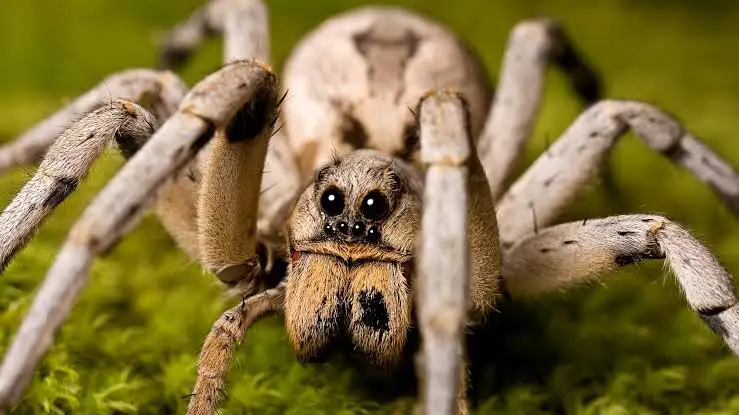
Wolf spider, also called ground spider or hunting spider is named for the wolf-like habit of chasing and pouncing upon prey. Most are small to medium-sized. The largest has a body about 2.5 cm (1 inch) long and legs about the same length. Wolf spiders commonly occur in grass or under stones, logs, or leaf litter. They are especially active at night or if the sky is overcast.
These are athletic spiders that don’t spin webs to catch their prey; instead, they run it down. They have long legs and are usually gray, brown, black, or tan with dark brown or black body markings (especially stripes).They are easily identified by the number and arrangement of the eyes: four small eyes in the lowest row, two very large eyes in a middle row, and two small or medium-sized eyes in a top row. The jaws are prominent and strong.
Six-Spotted Fishing Spider
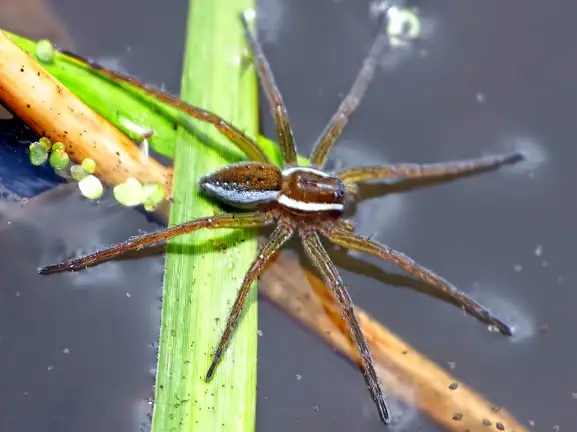
The spotted fishing spider lives in aquatic habitats and can run across the surface of water. This long-legged, dark-colored water spider is also distinctive in that the oval abdomen is smaller than the broad carapace (“head”). A pale, whitish-yellow stripe surrounds the dark carapace and sometimes also the abdomen. Viewed from above, several pairs of small, distinct white spots run down the length of the dark brown abdomen.
Apparently, the common name “six-spotted fishing spider” comes from six distinct dark spots on this spider’s rarely seen sternum (the underside of the carapace). The legs are robust and brown, dotted with white hairs. This spider runs quickly.
Black Widow Spider

Black widow spiders get their common name from the popular belief that the female eats the male after mating, a phenomenon which rarely happens in nature. Black widow spiders are typically black with two reddish triangular markings usually joined to form a reddish hourglass shape on the underside of their abdomen – their most recognized feature.
Females are occasionally brownish black. Most black widow spiders are 3 to 10 mm long, with females being larger than males. Black widow spiders have eight legs and eight simple eyes, including two lateral pairs that almost touch.
Black widow spiders are frequently found in low-lying webs in garages, in barbecue grills, around swimming pools, and in wood piles. Most bites occur in rural and suburban areas and occur between the months of April and October. These spiders tend to bite defensively when their webs are disturbed.
Hobo Spiders
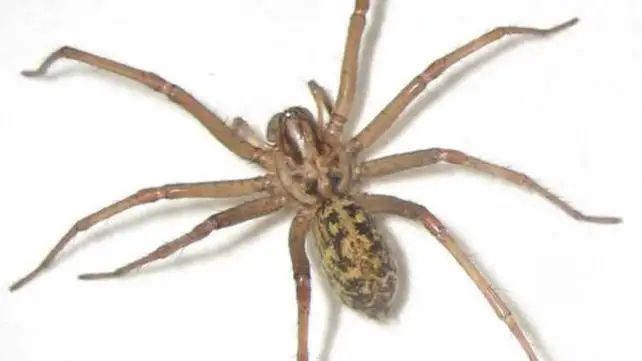
The common name for the hobo spider comes from its presumed method of expanding its distribution by hitching rides with humans along major highways in the Pacific Northwest. Mature female hobo spiders are 9.5-16.5 mm (3/8-5/8 in) long, and male hobo spiders are 7-13.5 mm (9/32-9/16 in) in body length. Males have enlarged pedipalps located near the mouth, resembling short legs.
Hobo spider greatly resembles certain other members of the funnel-web spider family, which are harmless, it has important distinguishing characteristics. The hobo spider has a brown cephalothorax (the front body region where the legs are attached) with darker brown markings and brown legs. The abdomen (the second body region) has a distinctive pattern of yellow markings on a grey background, although this pattern can be difficult to discern without the aid of a microscope or hand lens.
Hobo spiders frequent areas such as log or timber piles, rock piles/borders/retaining walls, holes, or where tall grass meets the foundation or crevices in soil or concrete where they can make their characteristic funnel webs. The webs are funnel shaped, sort of like a tornado but really wide at the top. The spider waits in the small hole at the bottom of the funnel for prey to make contact with the web.
Golden Silk
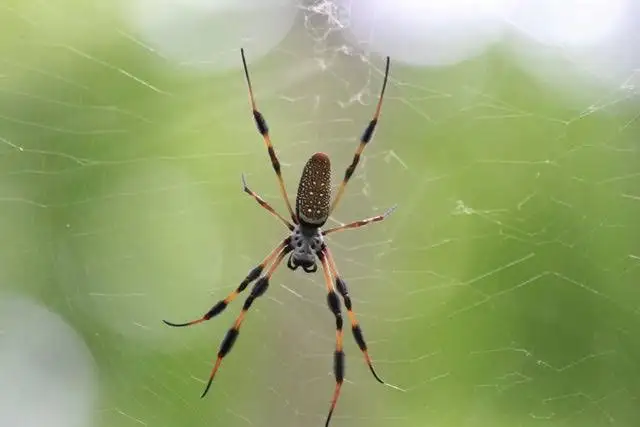
Trichonephila clavipes (formerly known as Nephila clavipes), commonly known as the golden silk orb-weaver, golden silk spider, or banana spider, ranges from 24 mm to 40 mm in length when fully developed. Known for the golden color of their silk, the large size of their females, and their distinctive red-brown and yellow coloring, Golden silk construct large, asymmetrical circular webs attached to trees and low shrubs in woods to catch small- and medium-size flying prey, mostly insects.
They are excellent web-builders, producing and utilizing seven different types of silk and they subdue their prey by injecting them with venom, as opposed to related species which immobilize their prey by wrapping them in silk first.
Females also have very distinct coloring, making the species relatively easy to recognize. They have a silvery white cephalothorax and a longer orange-brown abdomen with two rows of small white-yellow spots. The abdomen changes color as the spider matures. Their legs consist of dark yellow and brown banding, and the first, second, and fourth leg pairs also contain black brush-like tufts of hair near the joints.
Males, meanwhile, are much smaller, about one-third to one-quarter the size of females at roughly 6 mm in length, and also have a more slender build. Their mass is roughly between 1/30th and 1/70th that of a large female. Male coloration, meanwhile, is much less complex, consisting of a dark brown body and legs. Males’ legs contain a black band near the end of the tibial segment, in the same area as where the black hair tufts would be on a female.
Jumping Spiders
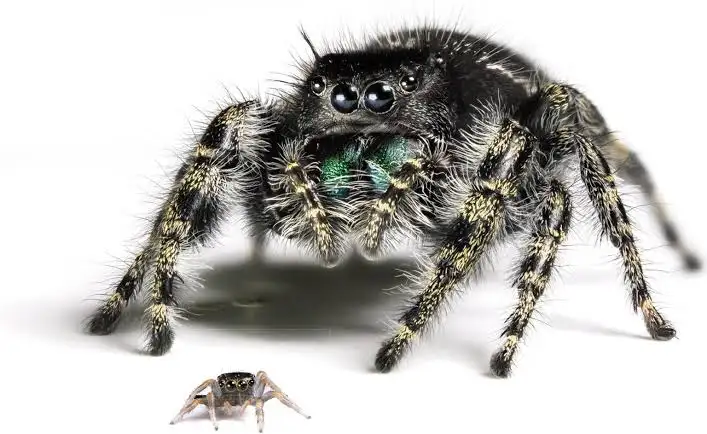
Jumping spiders or salticids are known for the spectacular leaps the spiders make pouncing on their prey. Like all spiders, jumping spiders are predators. They eat insects and other spiders. These spiders do not spin webs but make little silken shelters under leaves or bark.
Jumping spiders are commonly mistaken for black widow spiders due to their compact black bodies with relatively short legs. However, jumping spiders can also be brown, tan or gray in color with pale white, gray, yellow, red, blue or green markings. Adult jumping spiders range in size from about 1/8-3/4” (4-18 mm) and are typically covered in dense hairs or scales that are brightly colored or iridescent. Their front legs are usually thicker and somewhat longer than their other legs.
Redback Spiders

The redback spider also known as the Australian black widow is a species of highly venomous spider believed to originate in South Australia or adjacent Western Australian deserts. They are common in sheds and garages, under houses, in industrial areas and in outside toilets.
The body color of males and females typically is brownish or black, and both sexes have a reddish orange marking in the shape of an hourglass on the lower side of the abdomen. Males often have white markings on the upper side of the abdomen.
They further differ in appearance from females in size, measuring about 3 to 4 mm (0.12 to 0.16 inch) in body length, compared with 1 cm (0.4 inch) in females. Males also are shorter-lived, surviving several months to the females’ two or three years.
Brazilian Wandering Spiders
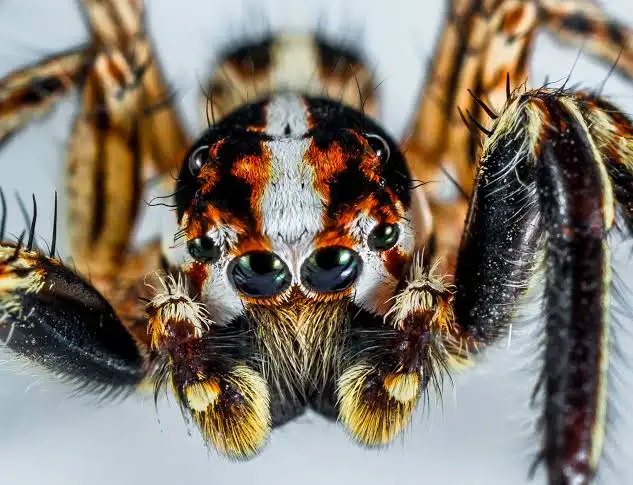
The Brazilian wandering spider can grow to have a leg span of up to 4 – 5 inches. They are large hairy spindly-looking spiders who have eight eyes, two of which are large. Brazilian wandering spiders are fast-moving spiders, their legs are strong and spiny and they have distinctive red jaws which they display when angered. The Brazilian Wandering spider is also called the ‘banana spider’ as it is occasionally found within shipments of bananas.
Cellar Spiders
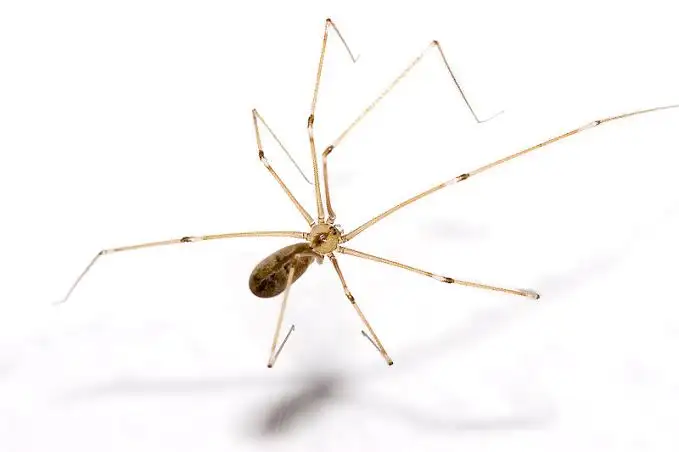
The cellar spider, also known as the daddy long-legs spider, is almost only ever found indoors, where they benefit from a warm, stable temperature. Cellar spiders spin loose, messy webs in the corners of rooms, usually where the wall meets the ceiling.
There are two groups of cellar spiders, the long-bodied cellar spiders that have legs up to two inches long and the short-bodied cellar spiders whose legs are about ½ inch long. All cellar spiders have oval-shaped bodies that range in color from pale yellowish to light brown or gray.
Like all arachnids, cellar spiders have eight legs; however, theirs are very elongated and thin compared to other spiders. Cellar spiders also have eight eyes that are arranged into two widely-spaced lateral groups of three each and two eyes in between. They have a cylindrical abdomen that is about three times longer than it is wide.
Funnel Web Spiders
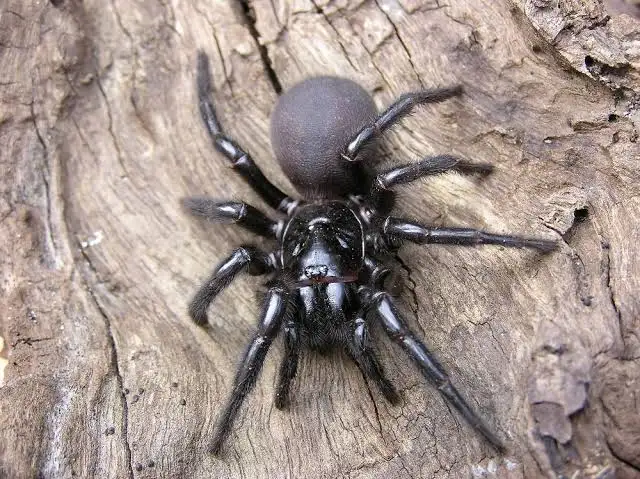
Funnel-web spiders are medium to large in size and are dark in color, ranging from black to brown. These spiders get their name because, generally, their webs have a flat surface for capturing prey and a small funnel-like tube leading to a silken burrow in which the spider hides. They are known to be among the most dangerous spiders in the world.
There are over 40 species of funnel-web spiders, with 3 genera restricted to Australia, including the Hadronyche, Illawarra, and the Atrax. Of all Australian spiders, one species of the Atrax genera, the Atrax robustus, is implicated in the most human fatalities. The Atrax robustus is known as the Sydney funnel-web spider and is native to eastern Australia. All funnel-web spider bites should be treated as potentially life-threatening, even though only approximately 10% to 15% of bites are venomous.
Australian funnel-web spiders make their burrows in moist, cool, sheltered habitats – under rocks, in and under rotting logs, and some in rough-barked trees (occasionally meters above ground). They are commonly found in suburban rockeries and shrubberies, rarely in lawns or other open terrain. A burrow characteristically has irregular silk trip-lines radiating from the entrance. Unlike some related trapdoor spiders, they do not build lids to their burrows.
Yellow Sac Spider
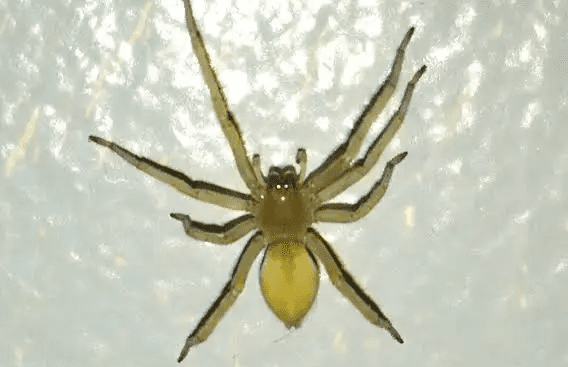
Cheiracanthium, commonly called yellow sac spiders are light yellow to pale yellowish green, sometimes with a orange-brown stripe on top of the abdomen. The cephalothorax (fused head and thorax) of the Yellow Sac Spider is orange brown to reddish and the abdomen is pale yellow to light grey. An adult female sac spiders body is typically 1/4 to 3/8 inches long and its leg span is up to 1 inch. The young spiders can be almost transparent and easily go unnoticed. The Yellow Sac spider spins a spherical web and is a hunting/wandering spider. This spider nests in undisturbed locations like corners, ceilings, around doorframes, behind pictures and seldom used clothing. Outdoors, this spider is found in bushes under leaves.
Garden Spiders
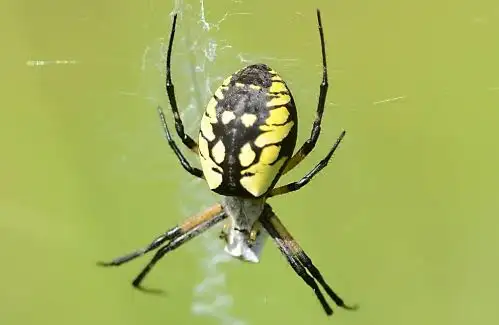
Garden spider (Argiope aurantia) is commonly known as the yellow garden spider, golden garden spider, zigzag spider, zipper spider, corn spider or McKinley spider is a member of the orb weaver family characterized by white marks arranged in the form of a cross on the abdomen. The garden spider occurs throughout the Northern Hemisphere and is often found in grassy areas and gardens, where it builds an orb-shaped web on low shrubs. The spider can also be found along the eaves of houses and outbuildings or in any tall vegetation where they can securely stretch a web.
Giant Huntsman Spiders

Huntsman spiders are large, long-legged spiders. They are mostly grey to brown, sometimes with banded legs. Many huntsman spiders, have rather flattened bodies adapted for living in narrow spaces under loose bark or rock crevices. This is aided by their legs which, instead of bending vertically in relation to the body, have the joints twisted so that they spread out forwards and laterally in crab-like fashion (‘giant crab spiders’). Huntsman Spiders are found living under loose bark on trees, in crevices on rock walls and in logs, under rocks and slabs of bark on the ground, and on foliage.
Trapdoor Spider
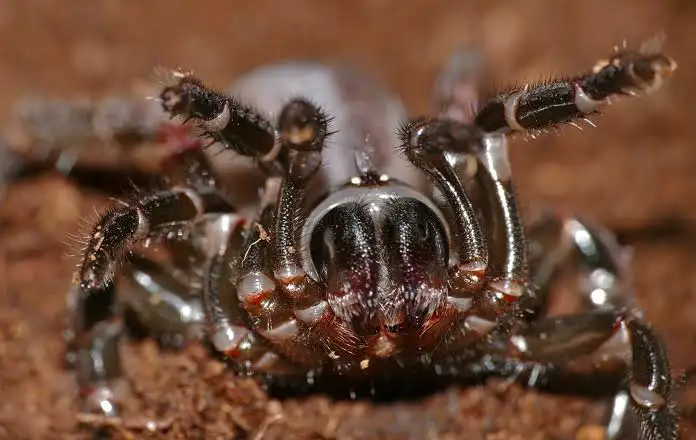
Trapdoor spider is a name given to a variety of tropical spiders that make their homes underground. Their name originates from the cork-like trapdoor that they build their nest under. Trapdoor spiders are often confused with the bigger and more dangerous funnel-web spiders. However, unlike the funnel-web spider, trapdoor spiders have brown mottled markings. Trapdoor spiders are close relatives of tarantulas but are smaller and less hairy. Their body is thinly covered in hair and they have eight eyes, a pair in the middle with three located on each side.
ORB Weaver Spider
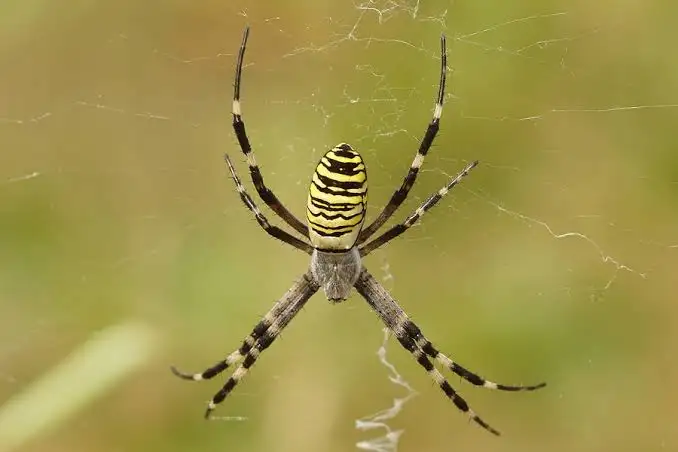
Many orb weavers are brightly colored and have hairy or spiny legs. Large distinctive webs of concentric circles, sometimes several feet across, are the best indication of the presence of an orb weaver spider. Most orb weavers appear in spring but are not noticed until they start building their large webs in the late summer or early fall. These are docile, non-aggressive spiders that generally will flee at the first sign of a threat.
St Andrews Cross Spider
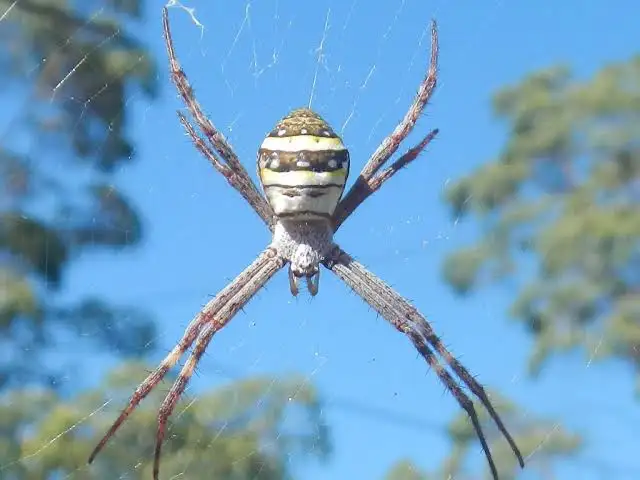
St Andrew’s Cross Spiders are named for their bright web decorations – zig-zag ribbons of bluish-white silk that form a full or partial cross through the centre of the orb web. Females have a silvery carapace and a silver, yellow, red and black banded upper abdomen with two longitudinal yellow stripes below. The spider sits with the legs in pairs. The brown and cream coloured males are smaller than females. The cream-coloured young spiders make a circular stabilimentum (like a white silk doily) that disguises them well and may also act as a sunshade. As the spider grows the ‘doily’ is gradually transformed into a ‘cross’.
Grass Spiders
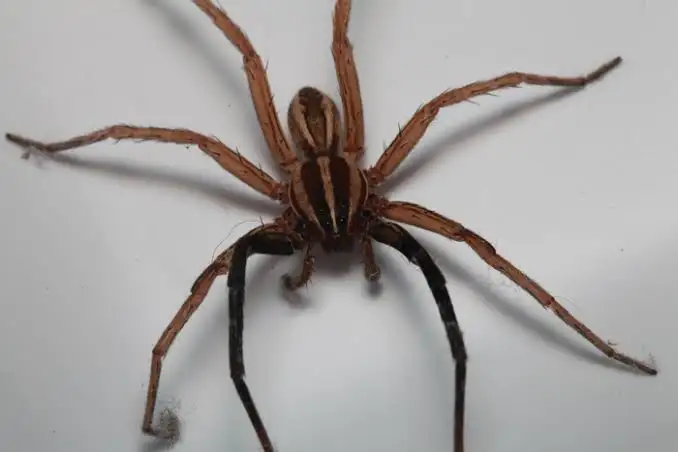
Grass spiders have a pair of broad, dark, brownish bands running lengthwise adjacent to a lighter middle band on the lightly haired and roundish carapace. The legs are cream and dark yellowish brown. The abdomen is oblong, brown, with a broad, reddish-brown, zigzag stripe with a cream-colored border on both sides. The unique web of grass spiders is more often noticed than the spider itself. The web is sheetlike, usually positioned horizontally, with a funnel leading downward to a shelter (a rock crevice or dense vegetation). Though it is often smaller, the sheet may be up to 3 feet wide and the funnel portion over a foot long.
Golden Silk Spider or Banana Spider

Golden Silk Spider also referred to as Banana spider is an orb-weaving spider species which inhabits forests and wooded areas. Females also have very distinct coloring, making the species relatively easy to recognize. They have a silvery white cephalothorax and a longer orange-brown abdomen with two rows of small white-yellow spots. The abdomen changes color as the spider matures. Their legs consist of dark yellow and brown banding, and the first, second, and fourth leg pairs also contain black brush-like tufts of hair near the joints. Males, meanwhile, are much smaller, about one-third to one-quarter the size of females at roughly 6 mm in length, and also have a more slender build. Their mass is roughly between 1/30th and 1/70th that of a large female. Male coloration, meanwhile, is much less complex, consisting of a dark brown body and legs. Males’ legs contain a black band near the end of the tibial segment, in the same area as where the black hair tufts would be on a female.
Crab Spider
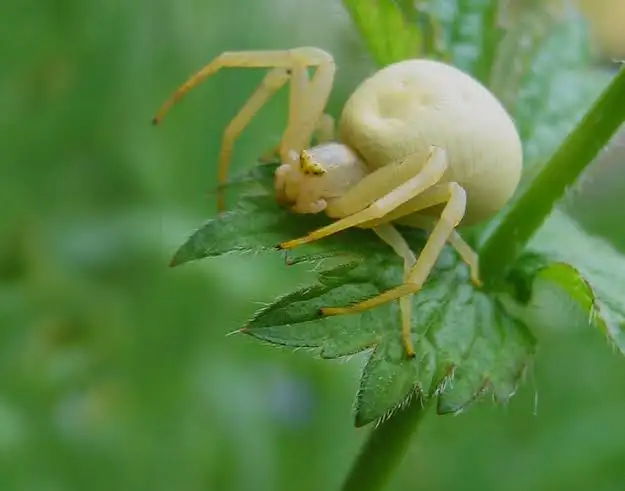
Crab Spiders usually have short, wide, flat bodies. The first two pairs of legs are larger than the back legs, and are usually held open so that the spider can easily grab its prey. They usually walk sideways or backwards, and use just their back legs. This is where they get their name. All crab spiders have eight eyes, and the eyes on the edges of their cephalothorax are often raised up on bumps, so they can see in all directions. These spiders have small fangs compared to other spiders, but their venom acts quickly to paralyze their prey.
In some species males and females are different colors, and males are often much smaller than females. Crab spiders usually are colored to match their habitat. Some species can slowly (over a period of days) change color to match the color of the flowers they are hiding on.
Harvestman Spider

Harvestman, also known by their common name, daddy longlegs, is a type of arachnid and belongs to the order Opiliones. Their name comes from their long, spidery legs which they can twitch and then break off from their body to survive predatory attacks. Their other name, harvestman, comes from the fact that they are mainly seen during harvest time, i.e between summer and fall. They are generally found in shaded, moist spaces like under logs, leaves and in damp spaces between buildings.
Button Spider
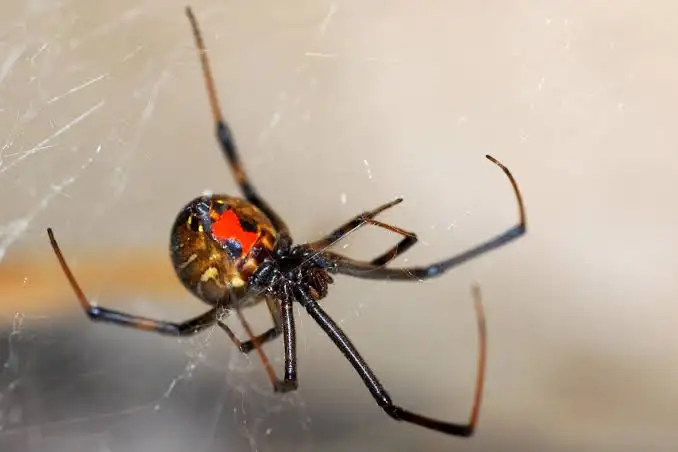
These common spiders are often found around human dwellings – in the garage, under window sills, in the swimming pool pump box… They build a messy web and have large white, spiky egg sacs. They are usually a brown colour with darker bands on the joint of each leg. The abdomen is grey to white often with a series of dots. The characteristic hourglass shape under the abdomen is orange to red. They are inoffensive and when disturbed, drop to the floor in a tight ball with the legs tucked in.
False Widow Spider

Similar to the true black widow, the false black widow female is 6 to 10.5 millimeters in length, but it lacks the red hourglass pattern on the underside of the abdomen, which is more oval in shape than that of the true black widow. In most specimens, the abdomen has a purplish-brown to black color with light, pale-yellow to grayish markings. In many specimens, these markings may be faded and difficult to see. The cephalothorax is a red-brown color with slightly darker legs. It is a common spider in homes and other structures. It makes an irregular web and is reported to capture and prey upon other spiders, including the true black widow spiders.
European Garden Spider
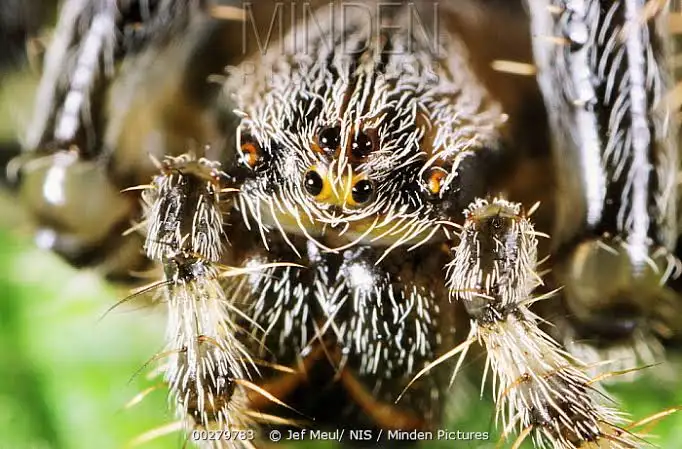
The European Garden spider belongs to the “orb weaver or cross orb weaver” group – spiders that spin wheel-shaped or circular webs. You can find their large (up to 40 cm in diameter) webs throughout your garden, especially in October. Females are usually much larger than males. Female spiders are easily identified by their expansive abdomens, attractive mottled coloration and furry legs. Each spider shows off a unique range of colours – yellows, oranges, browns, reds, whites, tans and dark greys. The mottled or crossed colours are arranged intermittently with white dots that form a cross-like arrangement on the back. Interestingly, the markings arise from cells filled with guanine, a byproduct of protein metabolism. European spiders, being carnivores, eat a variety of prey, including grasshoppers, mosquitoes, bees, wasps, aphids and flies.
Flower Spider

The flower spider is a color-changing spider that transforms its colors depending on the color of the flower it sits on. Their name is derived from the yellow or white-colored flowers like the goldenrod on which they sit. Flower spiders resemble the physical description of crabs as they walk sideways, including the normal forward and backward walk. The female spiderling has red stripes and is larger than male spiderlings. The male spiders have a brown thorax accompanied by a yellow or white abdomen.
Zebra Spider
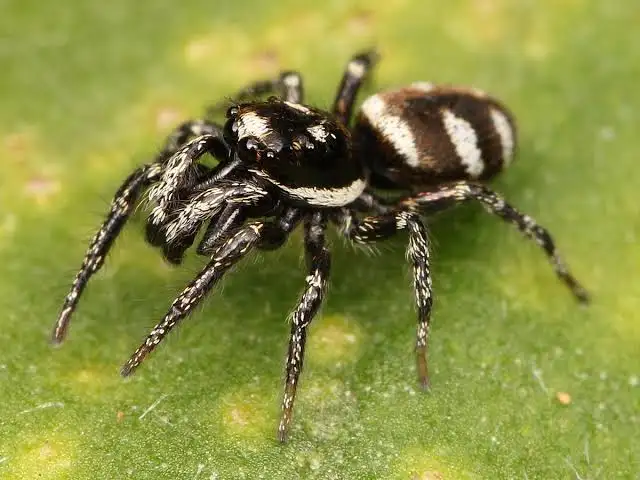
The Zebra Spider is a species of jumping spider (Salticidae) that is common, widespread and can be easily recognized in the field by the black and white stripy pattern of its body: abdomen usually black, with its anterior margin white and dorsally with 2 white stripes running toward the middle. Males usually have long and very pronounced brown chelicerae. As with all jumping spiders, the Zebra Spider has excellent binocular vision and it can jump, either while pouncing on its prey or when escaping its own enemies. The species can usually be observed on sunny walls of the buildings, in gardens and on rocks; it sometimes occurs on tree bark.
Woodlouse Spider
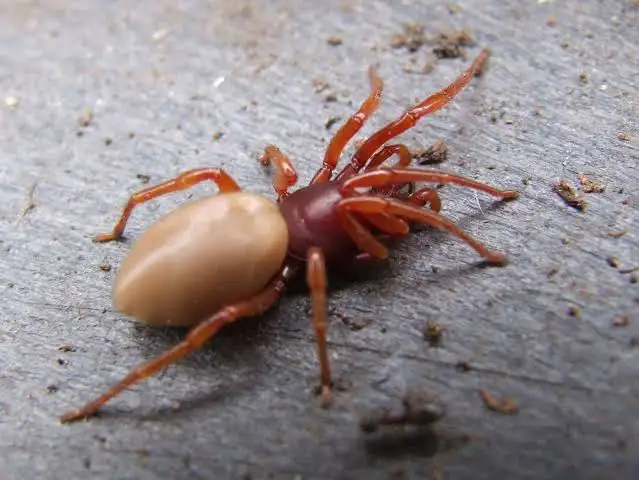
Woodlouse spiders are usually found under logs, rocks, bricks, plant pots and in leaf litter in warm places, often close to woodlice. They have also been found in houses. They spend the day in a silken retreat made to enclose crevices in, generally, partially decayed wood, but sometimes construct tent-like structures in indents of various large rocks. Woodlouse spiders hunt at night and do not spin webs. Rather than spinning their webs at night, they use this time to search warm places for prey.
Orchard Spider

The orchard orbweaver is a colorful, delicate spider that makes circular webs that are usually positioned horizontally or at an angle to the ground. The spider typically hangs in the middle of its web, its back to the ground. The carapace is yellowish green, with brown stripes on the sides. The abdomen is somewhat elongated. The top of the abdomen (which usually faces downward) is silvery with dark stripes; the belly (which usually faces upward) can be variably colored with silver, greens, yellows, reds, and some blues. There is usually a yellow, orange, or red crescent on the belly. The legs are slender and long. Males are usually only seen when they are in a female’s web courting or mating; they are smaller and their abdomens are more silvery-golden.
Filmy dome spider
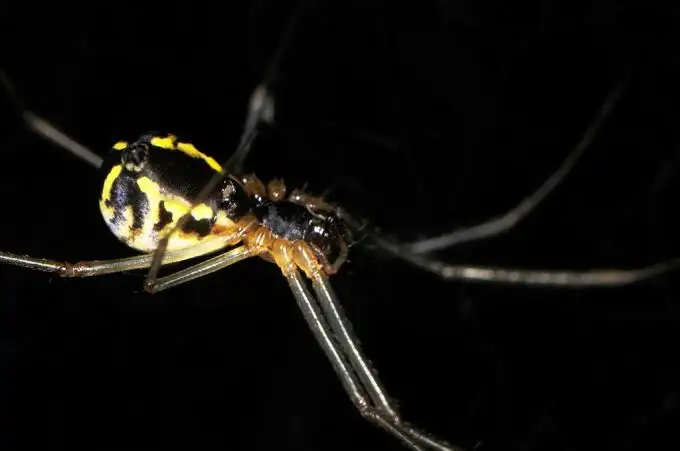
The filmy dome spider is one of the most abundant woodland and grassland areas. Although the spider is tiny, its snare web, which looks like an upside-down silk bowl, is conspicuous throughout the year. The carapace (head) of this spider is marked with a broad, dark brown middle band with white outer margins. The yellowish-white abdomen is wide and high at the back end, with distinctive mottled brown markings.
Banded Garden Spider
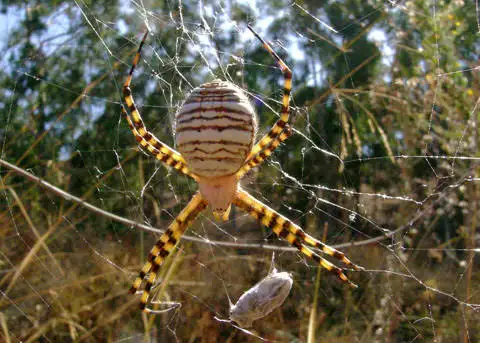
The banded garden spider female is 15 to 25 millimeters in length—slightly smaller than the yellow garden spider. The carapace is covered with silvery hairs. The abdomen is an elongated oval with the posterior somewhat point-ed and the anterior rounded without the humps or notch described in the yellow garden spider. The abdominal background color is a pale yellow/silver with numerous lateral bands or stripes of black. The legs are also a pale yellow with darker spots or bands.
The males are 4 to 5 millimeters in length and their abdomens are mostly white. The immature banded garden spiders also have a mostly white dorsal surface of the abdomen. The egg sac is similar in texture and color as that of the yellow garden spider, but it is shaped more like a kettledrum.